Picture two employees in completely different roles; a sales manager in Singapore and a product designer in Berlin. Both are delivering excellent results, yet the way they achieve those results could not be more different. One thrives on relationship-building and quick decision-making, while the other excels through precision, innovation, and deep technical knowledge.
Competency-based performance management recognises that performance is not just about hitting numbers. It is also about the skills, behaviours, and attributes that drive those numbers. By clearly defining the competencies that matter for each role and linking them to measurable outcomes, organisations can evaluate people more fairly, identify development needs faster, and create career paths that make sense for each individual.
This approach moves beyond a single scoreboard. It gives leaders a way to see the how behind the what, ensuring that high performance is both measurable and sustainable across different teams, functions, and geographies. In practice, it means building a framework where competencies are not abstract HR jargon but active drivers of recruitment, training, promotions, and succession planning.
Key Takeaways
- Competency-based performance management measures both results and the skills and behaviours that drive them
- Clear competency frameworks help align hiring, training, and career growth with business goals
- Observable behavioural indicators remove guesswork from performance reviews
- Localised competency definitions make global standards relevant in different markets
- Real-time tracking and regular calibration keep assessments fair and consistent
- Competency data supports succession planning by identifying future leaders early
What is Competency-Based Performance Management?
Competency-based performance management is a system where performance expectations are defined not just in terms of outcomes, but through the skills, behaviours, and knowledge that consistently produce those outcomes. Instead of treating competencies as a generic checklist, this approach positions them as operational levers that guide hiring, training, goal-setting, and career progression.
A well-built competency framework ensures that performance discussions move beyond “what was delivered” to “how it was delivered”; giving organisations a richer, more actionable view of individual and team contributions.
Core aspects include:
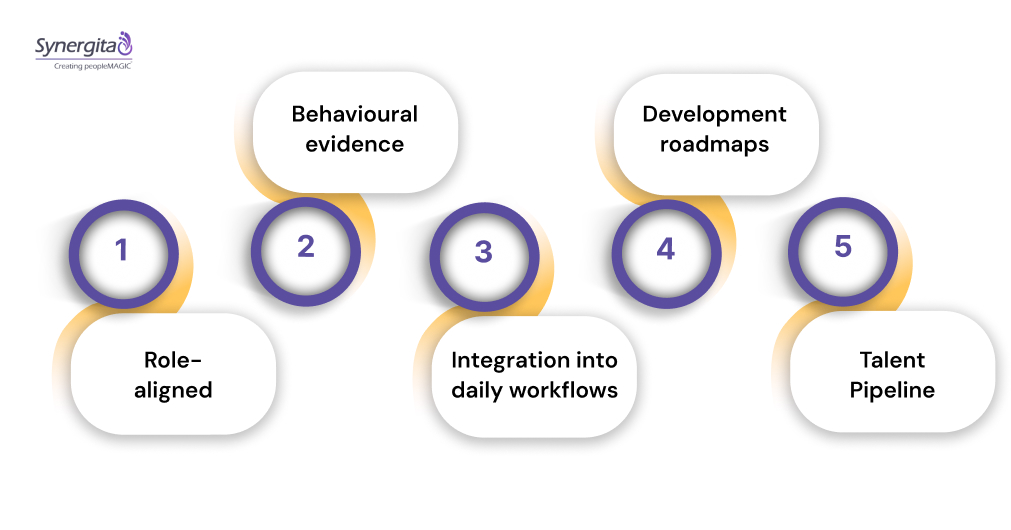
- Role-aligned competency models that describe the exact capabilities needed at different proficiency levels for each position.
- Behavioural evidence that turns abstract competencies into clear, observable actions managers can assess in real work situations.
- Integration into daily workflows so competencies actively shape decisions in recruitment, project allocation, and promotions.
- Development roadmaps that help employees close skill gaps in a structured and measurable way.
- Performance-linked succession planning to identify and prepare future leaders based on consistent, role-relevant criteria.
When executed well, competency-based performance management becomes an ongoing cycle of defining, assessing, and strengthening the abilities that have the greatest impact on organisational success; making it both a talent development tool and a business performance driver.
Key Capabilities of Competency-Based Performance Management
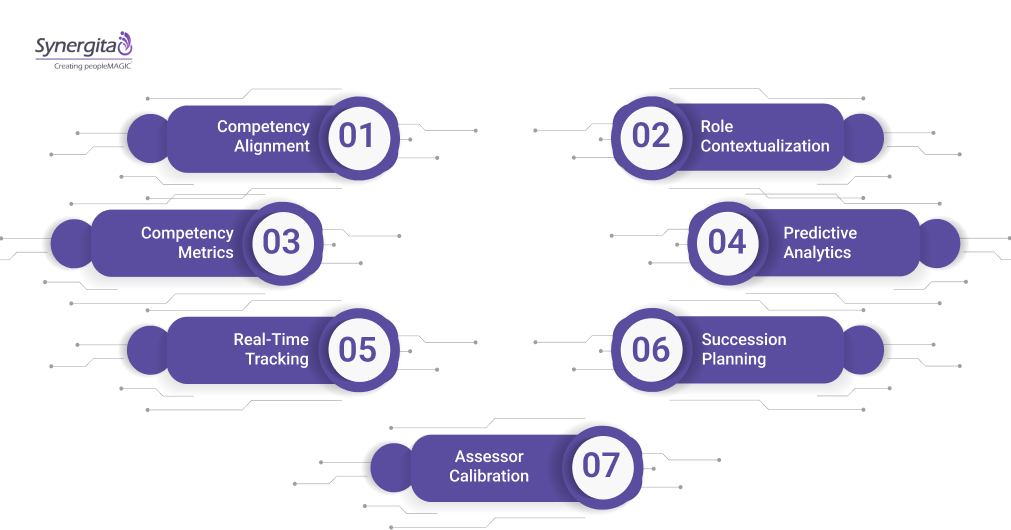
To transform competency-based performance management from a theoretical model into a working business tool, organisations need to embed certain operational capabilities that connect it to real decision-making and measurable results. These capabilities ensure that competencies don’t just sit in a framework; they actively influence hiring, development, and leadership pipelines.
1. Cross-Functional Competency Alignment
Competencies should not exist in isolation within departments. An effective system aligns shared competencies across roles while maintaining function-specific depth. For example, “strategic thinking” may be a shared competency across sales, marketing, and product teams, but its behavioural markers will vary by role and context.
2. Role Contextualisation in Global Teams
In multinational organisations, the same competency may require adaptation to fit market realities. For instance, “negotiation skills” for a sales manager in Singapore could focus on relationship-driven, consensus-based tactics, while in Berlin, it might emphasise assertive contract structuring. This localisation ensures performance standards are relevant everywhere they are applied.
3. Measurable Competency Indicators
Each competency needs quantifiable signals of proficiency. These can include project turnaround times, defect rates, innovation metrics, or customer satisfaction scores directly tied to observable behaviours. This bridges the gap between abstract skills and business KPIs.
4. Integration with Predictive Talent Analytics
When paired with analytics tools, competency data can predict role fit, flight risk, and readiness for promotion. This capability allows leadership to make proactive moves; reassigning talent before performance dips, or fast-tracking high-potential employees before competitors recruit them.
5. Real-Time Competency Tracking
Rather than assessing competencies only during scheduled reviews, advanced systems track behavioural indicators continuously. Inputs can come from collaboration tools, project management systems, or client feedback, providing a live view of strengths and gaps.
6. Competency-Driven Succession Planning
By maintaining a database of current proficiency levels across the organisation, leaders can quickly identify who meets the competency requirements for emerging leadership roles. This avoids the guesswork that often plagues succession decisions.
7. Continuous Calibration Across Assessors
To maintain fairness, managers evaluating the same competency must apply consistent criteria. Calibration sessions, supported by anonymised case studies and rating comparisons, help prevent subjective bias from skewing results.
How to Implement Competency-Based Performance Management in Real Workflows
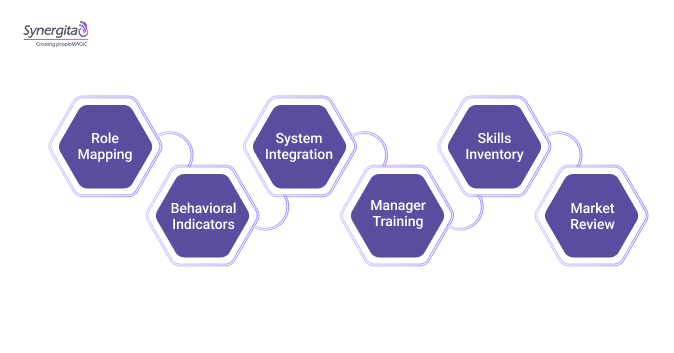
A well-designed competency framework is only useful if it is embedded into daily operations and decision-making. In practice, that means aligning it with business goals, data systems, and cultural realities, not just printing a list of skills in an employee handbook.
1. Map competencies to business-critical roles before you map them to individuals
Start by analysing the roles that have the most direct impact on revenue, customer retention, compliance, or innovation. Identify which competencies actually drive those outcomes in your context. For example, in a SaaS company, “data-driven decision-making” for a Customer Success Manager might include interpreting churn analytics, while for a Product Manager it could mean prioritising features based on usage patterns.
2. Define behavioural indicators that hold up in performance reviews
Vague descriptions like “good communicator” lead to subjective scoring. Replace them with concrete, observable actions. For instance, a “collaboration” competency might specify “shares project status updates in sprint retrospectives without prompting” or “resolves inter-team conflicts within agreed timelines.” This makes the competency measurable in day-to-day work, not just in annual appraisals.
3. Integrate competencies into your performance systems and workflows
A competency model should not live in isolation. Embed it into:
- Job descriptions and recruitment scorecards so candidates are evaluated on the same criteria they will be reviewed against later
- Goal-setting tools where performance KPIs are linked to relevant competencies
- Learning management systems so development plans automatically align to competency gaps
4. Build manager capability for consistent assessment
The framework fails if two managers rate the same behaviour differently. Run calibration workshops using anonymised examples from real projects so managers interpret “meets expectations” or “exceeds expectations” the same way. This reduces bias and builds trust in the system.
5. Use analytics to create a live skills inventory
Go beyond static ratings by using HR tech to collect ongoing competency signals from multiple data sources. This could include customer feedback forms, peer reviews in collaboration platforms, or ticket resolution data from service tools. Over time, you can see which competencies are trending up or down across departments and adjust your workforce plans accordingly.
6. Keep competencies relevant by reviewing them against market changes
Technology shifts, regulatory updates, and competitive pressure can make certain skills obsolete quickly. Schedule quarterly or biannual reviews to validate whether your competencies still reflect the capabilities your business needs to compete.
Common Challenges in Competency-Based Performance Management and How to Overcome Them
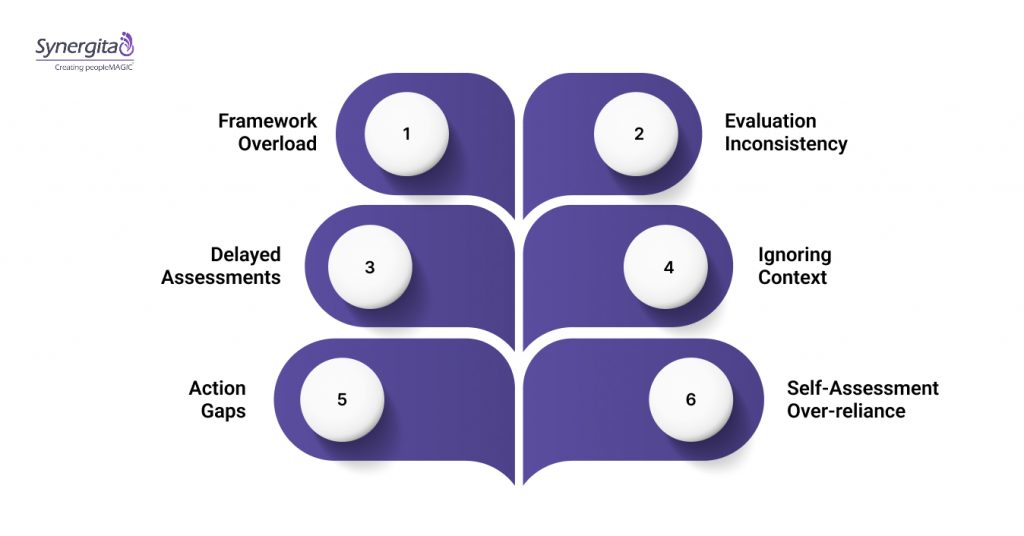
Even with a strong framework, competency-based performance management can face operational and cultural roadblocks that slow adoption or weaken its impact. These issues are not about the concept itself but about execution in complex environments.
1. Overloading the Framework
When teams attempt to include every possible skill, the framework becomes cluttered and impractical. This often leads managers to focus only on a few familiar competencies and ignore the rest. The solution is to identify a small set of critical competencies that directly influence business outcomes for each role. Less critical capabilities can be documented separately in a development library and revisited only when needed.
2. Inconsistent Evaluation Across Managers
Even with documented definitions, managers interpret competencies differently based on their personal experiences. This can create performance ratings that vary widely for the same behaviours. To prevent this, organisations should run calibration sessions where managers review anonymised case examples, compare ratings, and align on what each level of proficiency truly looks like in practice.
3. Delayed or Outdated Assessments
When competency evaluations only happen during annual reviews, the data quickly becomes stale. By the time skill gaps are identified, project requirements or market conditions may have changed. The fix is to gather competency signals continuously through project reviews, collaboration tools, and client feedback so performance data stays current.
4. Ignoring Local Context in Global Teams
Applying one universal definition for a competency across regions can cause misalignment. For example, negotiation skills in some cultures rely heavily on relationship-building while in others they are driven by formal contract structures. The core definition can remain global, but the behavioural markers should reflect local business practices and norms.
5. Competency Gaps Without Action Plans
Identifying a gap is not enough. Many organisations stop at the assessment stage without linking results to actionable steps. Each gap should be connected to a structured development plan that includes targeted learning modules, mentoring, or stretch assignments, along with a timeline and regular check-ins to track progress.
6. Over-Reliance on Self-Assessment
Employees often misjudge their own proficiency levels. This creates skewed datasets that cannot be relied upon for promotion or training decisions. A balanced approach that combines self-assessment with peer feedback, manager input, and measurable performance metrics produces a more accurate competency profile.
How Synergita Embeds Competency-Based Performance Management
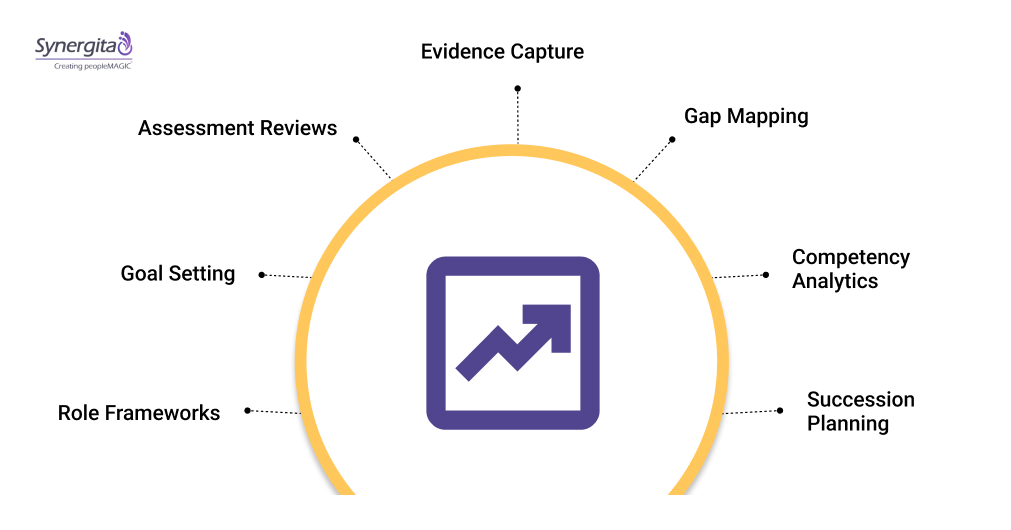
Synergita’s platform operationalises competency-based performance management by integrating it into every stage of the employee lifecycle, ensuring competencies are not just defined but actively applied.
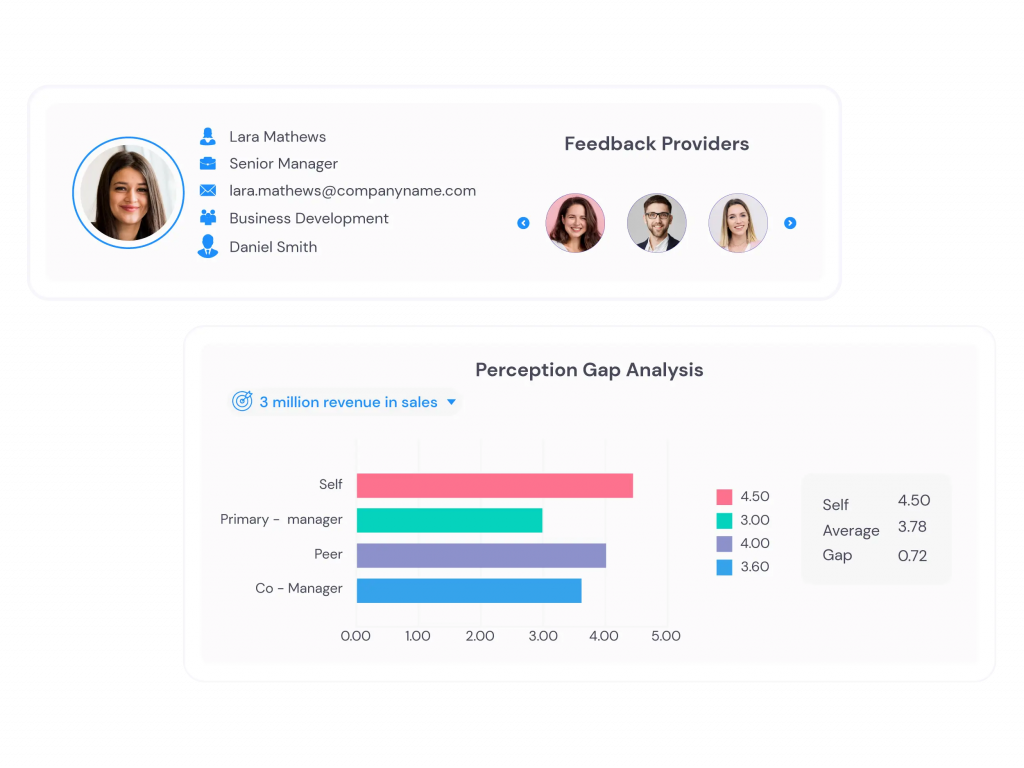
1. Role-Based Competency Frameworks in the System
Synergita lets HR teams build digital competency libraries mapped to each role. For example, a sales manager role can have competencies like “Client Relationship Building” and “Negotiation Skills,” each defined with behavioural descriptors for beginner, intermediate, and advanced levels. A product designer’s framework might include “User-Centric Design Thinking” and “Prototyping Accuracy,” with its own measurable criteria. These are stored centrally and linked to performance forms so they cannot be overlooked during evaluations.
2. Competency-Linked Goal Setting
When managers and employees set performance goals in Synergita, the platform prompts them to link each goal to relevant competencies. This ensures that even target-driven objectives are grounded in the underlying skills and behaviours needed to achieve them. For instance, a “Launch new product feature by Q3” goal could be tied to “Innovation” and “Cross-Functional Collaboration” competencies.
3. Embedded Competency Assessment in Reviews
During performance appraisals, the review form in Synergita includes a dedicated section for competency ratings. Managers select the relevant competency level achieved and provide real-time evidence such as project outcomes, peer feedback, or customer testimonials. The system standardises the scale so ratings remain consistent across reviewers.
4. Real-Time Evidence Capture
Synergita’s continuous feedback feature allows managers and peers to log competency-related observations throughout the year. For example, after a client presentation, a manager can record a note under “Presentation Skills,” tagging it to the relevant project and attaching files or meeting recordings. This builds a living record of competency evidence instead of relying on end-of-year recall.
5. Automated Gap-to-Training Mapping
When a review identifies a gap, such as a mid-level leader scoring low in “Conflict Resolution”; Synergita automatically recommends development actions. These can be internal training modules, external courses, mentorship pairings, or stretch assignments. The progress is tracked in the platform, and follow-up assessments measure improvement.
6. Competency Analytics for Workforce Decisions
Synergita’s analytics dashboard lets HR and leadership filter employees by competency strength, readiness level, and gap severity. For example, if a regional office plans to expand into a new market, leaders can identify employees already at an “Advanced” level in “Market Expansion Strategy” for deployment.
7. Succession Planning with Competency Data
For critical roles, Synergita matches live competency data with role requirements. If the VP of Operations role needs “Strategic Thinking” at the highest proficiency level, the platform can instantly pull a shortlist of employees who meet or exceed that benchmark, along with their supporting evidence and development history.
Final Thoughts
Competency-based performance management is most effective when it stops being an annual HR ritual and becomes part of everyday decision-making. By translating role expectations into measurable skills and behaviours, it gives managers a clear lens for evaluation, employees a transparent growth path, and leadership a data-backed foundation for workforce planning. Done right, it fuels both individual performance and long-term organisational agility.
Start your free trial with Synergita and see how competency frameworks work in real time.
FAQs
Q: What are the 5 C’s of performance management?
A: They are Clarity, Consistency, Communication, Coaching, and Continuous Improvement. Together, they ensure goals are clear, feedback is ongoing, and performance expectations stay aligned with business objectives.
Q: What are the 3 Ps of performance management?
A: They stand for Purpose, Process, and People. Purpose defines why performance is being measured, Process outlines how it will be managed, and People ensure the right stakeholders are involved in reviews and decisions.
Q: What is one key challenge to implementing a competency-based performance management system?
A: Securing organization-wide buy-in is often difficult. Without leadership commitment and manager alignment, the framework risks becoming a one-time HR exercise rather than a daily performance driver.
Q: What is an example of a competency-based approach?
A: A customer service role might be assessed not just on resolution time but on competencies like active listening, empathy, and conflict resolution, with ratings tied to observed behaviors in real interactions.
Q: What are the 7 core competencies in CBC?
A: They commonly include Communication, Critical Thinking, Collaboration, Creativity, Citizenship, Character, and Cultural Awareness. These serve as a foundation for performance and development goals.
Q: Which method is commonly used in competency-based assessment?
A: Behavioral event interviews are widely used. They focus on real examples from past experiences to evaluate how consistently an individual demonstrates required competencies.


